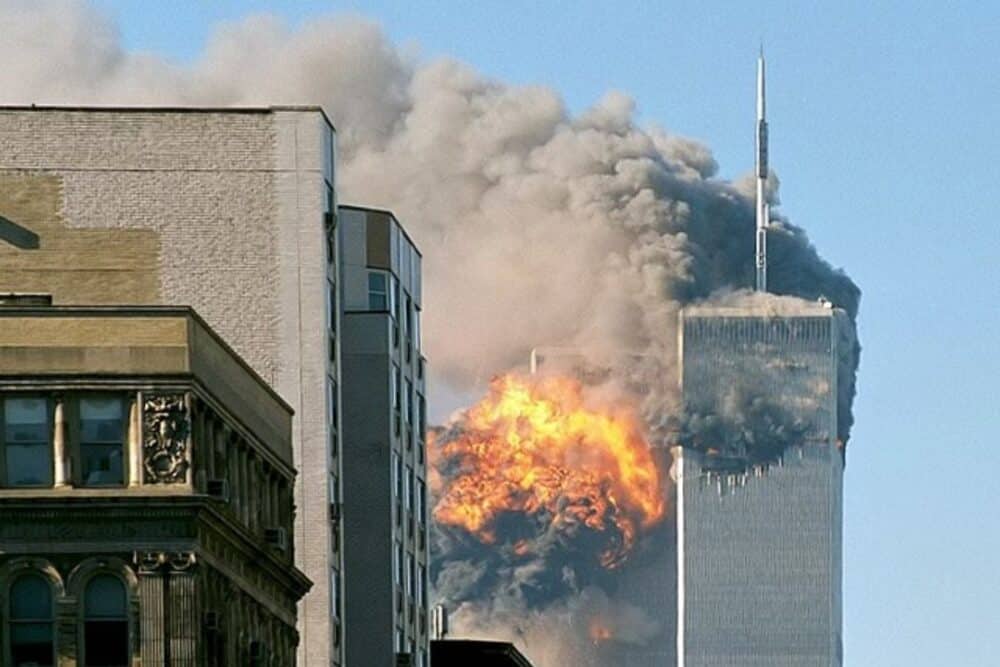The attacks on the World Trade Center by Al Qaeda on September 11, 2001 was an event as surprising as it was tragic. A painstaking investigation involving state-of-the-art modeling has lowered the chances of it happening again. DirectIndustry e-magazine interviewed several industrial engineers to investigate how the Twin Towers concretely collapsed.
A Devastating Drop
Twenty years ago to this day, on the morning of September 11, 2001, terrorists deliberately flew two hijacked planes into each of the two towers of the World Trade Center (WTC) in New York City, marking the deadliest terrorist attack in US history. By 10.30 am, both of these iconic, 400-meter-plus skyscrapers had completely collapsed, causing more than 2700 fatalities.
The destruction of such massive buildings not only shocked the world but led a growing number of people to ask the question – what caused the Twin Towers to drop in such a devastating fashion?
Anatomy of a Collapse
From their construction in 1973 and until 9/11, the Twin Towers were the tallest buildings in the world. One World Trade Center (WTC 1) the “North Tower” was 417 meters high while the Two World Trade Center (WTC 2) the “South Tower”, stood at 415 meters.
Designed by Japanese architect Minoru Yamasaki, the Twin Towers utilized a novel design that involved a square tube supported by a central core. This new framed-tube structure offered large, uncluttered floors without columns or walls. It also required 40% less steel than more traditional steel-framed skyscrapers.
Forty percent of the weight of the towers was carried by their facades made of 236 steel columns. 60% rested on the central core composed of 47 steel columns. The floors were made of 10 centimeters thick light concrete slabs resting on a steel lattice.
The designers and structural engineers had taken into account the effects of a commercial airplane impact and believed that the structures would remain standing should such an event occur. But when the two Boeing 767 hit the towers at 700 and 900 km/h on September 11, 2001, the scenario was quite different.
Unprecedented Failure
The hijackers launched two Boeing 767 into the towers: a Boeing 767-200ER (American Airlines Flight 11) hit the North Tower at 8:46 a.m between the 99th and 93rd floors, while a Boeing 767-200 (United Airlines Flight 175) hit the South Tower at 9:03 am between the 85th and 77th floors.
For the first tower to be hit, the North Tower, the plane was flying at 700 km/h and hit the upper floors. The tower remained standing longer before collapsing.
For the second tower, WTC 2, the plane arrived at 900 km/h and destroyed 8 floors, and 33 exterior columns including 10 of the central core. The tower initially resisted, but the lightweight construction, hollow structures, and blown thermal insulation by the plane allowed the kerosene to penetrate the interior of the towers, igniting numerous fires simultaneously over a large area of the affected floors.
The temperature of the fires reached 1000°C, weakening the steel columns and reducing their ability to support the upper mass of the building. The tower, therefore, collapsed in just 10 seconds.
Thomas Eagar, Professor of Materials Engineering and Engineering Management at the Massachusetts Institute of Technology (MIT), who has authored a paper on the collapse said:
“From an engineering perspective, the sudden and dramatic failure of two such buildings was unprecedented. Despite the magnitude of the impacts, a lot of structural engineers and veteran disaster investigators were stunned that it had happened. Immediately afterward there was widespread speculation that the buildings were structurally deficient, that the steel columns had melted, or that the failure of the fire suppression equipment had been an important factor. Subsequent investigations, which clarified all of these issues, disproved many initial theories.”
Multimillion-dollar Investigation
Shortly after 9/11, the Federal Emergency Management Agency (FEMA) and the American Society of Civil Engineers (ASCE) assembled a group of scientists and engineers. The aim was to investigate the collapse of the Twin Towers and of a third and smaller building nearby, WTC 7, whose collapse would generate controversy and conspiracy theories.
Analyzing videos, eyewitness accounts, and debris, the team published a hypothetical report on the causes in April 2002. This was followed by a far more thorough and better-funded investigation by the National Institute of Standards and Technology (NIST). This took around three years to complete.
Dr. Therese McAllister, a structural engineer with NIST who played a key role in investigating the collapse, explained:
“The goals were to look at the construction of WTC 1 and WTC 2, the materials used, and the technical conditions that contributed to the outcome of the disaster. There were many questions that needed to be answered, chief among them being how and why these buildings collapsed following the initial impact of the aircraft, and how we could minimize the chances of a similar event occurring in the future.”
The NIST Hypotheses
The NIST investigation considered several hypotheses for the collapse of WTC 1 and WTC 2, complementing its in-house expertise with an array of technical specialists. A total of more than 200 staff – including about 85 career NIST experts and 125 leading experts from the private sector and academia – poured over tens of thousands of documents. They interviewed more than 1,000 people, reviewed thousands of videos and photographs, analyzed 236 pieces of steel from the wreckage, and performed laboratory tests involving large fires and the heating of structural components.
Regarding WTC 7, the third building that collapsed at the WTC site later in the day on 9/11, several engineers felt that its sudden drop must have been the result of controlled demolition. According to NIST, however, uncontrolled fires on multiple floors, caused by debris dropping from WTC 1 and 2, led to its collapse. This was the first time that a building of this kind had rapidly and completely collapsed due to fire.
The NIST investigation into WTC 7 was published in 2008 and some people still dispute it. However, the idea that people somehow snuck into the building undetected and planted explosives is absurd. Besides, there were no sounds of explosions when the building fell.
Cutting-edge Modeling
The NIST investigators then developed sophisticated computer models. This helped them understand how each tower was damaged by the initial airplane impact, how the aviation fuel that each plane carried was dispersed, how fires subsequently evolved across multiple floors, and how building structures heated and eventually failed.




Dr. Therese McAllister explained:
“Using SAP2000 version 8 software, a global, three-dimensional reference model of each tower was developed that encompassed the 110 stories above ground and six subterranean levels. Another finite element package, LS-DYNA, that could accommodate a far higher level of detail for the building components and the highly non-linear behavior of the tower and aircraft materials, was used for the impact simulations.”
Modeling these intricate structures and thermal processes tested the limits of technology at the time. It pushed software tools and computer hardware to their boundaries. The team innovated by creating new modeling techniques, like mapping fire temperatures onto the towers’ structural elements.
McAllister adds:
“Finally, a separate global analysis of each tower helped determine the relative roles of impact damage and fires with respect to structural stability and the sequential failure of components and subsystems. This was used to determine the probable sequence of events leading to the collapse.”
Falling Dominoes

Published in 2005, the final NIST report was widely accepted by the structural engineering community. It concluded that the 2 towers had fallen because the impact of the planes severed and damaged support columns. It also dislodged fireproofing insulation coating steel columns and floor trusses, and widely dispersed jet fuel over multiple floors.
Although the fires didn’t melt steel, they gradually weakened the floors and columns. This caused them to sag and pull inward due to dislodged fireproofing. This resulted in the bowing of perimeter columns. And it led to the failure of the south face of WTC 1 and the east face of WTC 2, triggering the collapse of both buildings. WTC 2 collapsed more quickly than WTC 1 because it experienced more damage to its core.
Thomas Eagar says:
“Every large building has a redundant design that allows for loss of one primary structural member, such as a column. But when multiple members fail, as they eventually did in both buildings, the shifting loads eventually overstress the adjacent members and the collapse occurs like a row of dominoes falling down.”
The Lessons of September 11
The fall of WTC 1 and WTC 2 on September 11, 2001, posed questions about the stability of tall buildings in fire. Understanding the collapse of the Twin Towers offered the opportunity to learn useful engineering lessons and improve tall building design. For Thomas Eagar,
“It’s important to note that the Twin Towers were not defectively designed. Skyscrapers are designed to support themselves for three hours in a fire, even if the sprinkler system fails to operate. This should be long enough to evacuate the occupants. The WTC towers lasted for one to two hours – less than the design life, but only because the fire fuel load was so large.”
Following 9/11, NIST nevertheless issued many recommendations to improve the safety of tall buildings. This included also the emergency response in the face of major threats. Many of the recommended changes have been adopted in building and safety codes across the US.
Buildings over 130 meters tall must now have an additional exit stairwell or a specially designed evacuation elevator. Stairwells in buildings over 22 meters high must feature glow-in-the-dark markings, and fire-resistant materials must be significantly improved.
Many projects, including One World Trade Center, part of the new World Trade Center complex, implemented these recommendations. The tallest building in the US was built to resist a terrorist attack such as the 9/11 attacks.











